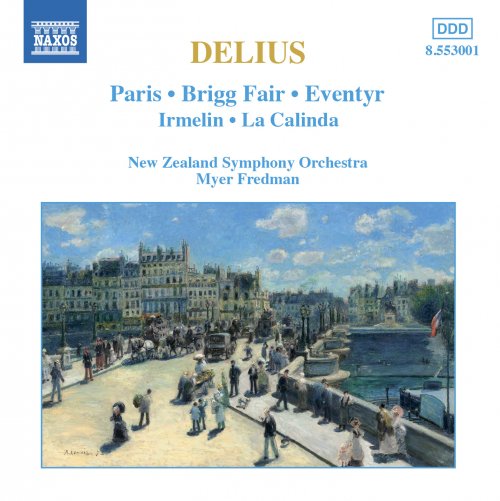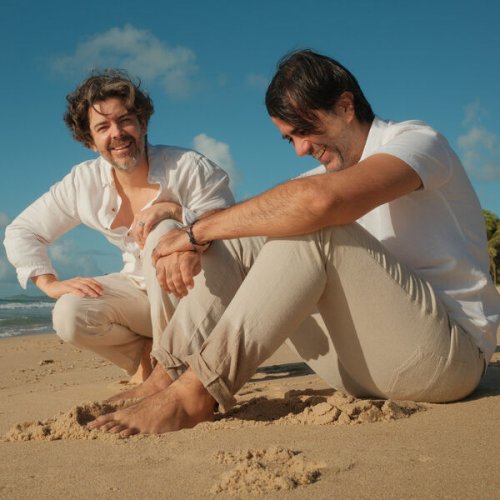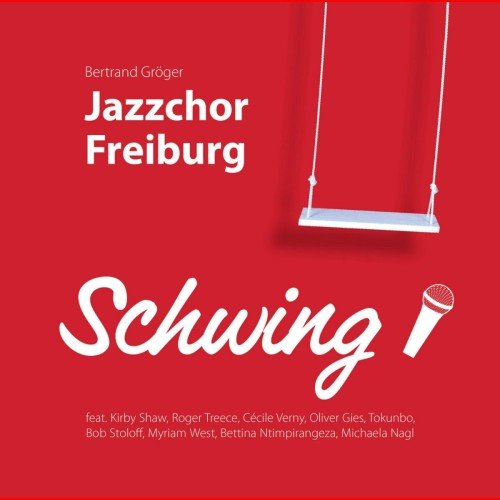New Zealand Symphony Orchestra, Myer Fredman - Delius: Paris / Brigg Fair / Eventyr / Irmelin / la Calinda (1995)

Artist: New Zealand Symphony Orchestra, Myer Fredman
Title: Delius: Paris / Brigg Fair / Eventyr / Irmelin / la Calinda
Year Of Release: 1995
Label: Naxos
Genre: Classical
Quality: flac lossless (tracks) +Booklet
Total Time: 01:03:50
Total Size: 237 mb
WebSite: Album Preview
TracklistTitle: Delius: Paris / Brigg Fair / Eventyr / Irmelin / la Calinda
Year Of Release: 1995
Label: Naxos
Genre: Classical
Quality: flac lossless (tracks) +Booklet
Total Time: 01:03:50
Total Size: 237 mb
WebSite: Album Preview
01. Paris: the Song of a Great City
02. Brigg Fair (An English Rhapsody)
03. Eventyr, "Once Upon a Time": Eventyr (Once Upon a Time)
04. Irmelin: Irmelin: Prelude
05. Koanga, Act II: La Calinda (arr. E. Fenby)
Frederick Delius was born in the Northern English industrial city of Bradford in 1862 into a family of German extraction and joined his father’s business once his schooling was over. Unsuited to the career his father had intended for him, he borrowed from his father enough money to set himself up in a business of his own as an orange plantation owner in Florida. Here he was able to further his musical interests notably with lessons from Thomas Ward in Jacksonville and by contact with the various musicians either living there or visiting the town in the winter months. He later moved to Danville in Virginia abandoning his plantation and seeking now to earn a living as a musician. It was at this time that his father agreed to allow him to train as a musician at Leipzig Conservatory which Delius entered in the summer of 1886 studying with Reinecke, Jadassohn and Sitte and forming an important friendship with Grieg. It was through the latter that paternal support was extended to Delius allowing him to move to Paris and settle there as a composer. His meeting with the young painter Jelka Rosen led to a liaison. In 1897 they set up house together in Grez-sur-Loing and married in 1903.
Much of the rest of the life of Delius was spent at Grez-sur-Loing. During the war years it was necessary to take refuge in England, a time of some difficulty in the absence of the usual royalty payments from Germany. After the war he returned to France, but gradually succumbed to the effects of syphilis possibly contracted in the US suffering blindness and paralysis. For the last six years of his life he was assisted in his composition by the young Yorkshire musician Eric Fenby who served as his amanuensis. He died in 1934.
As a composer Delius won considerable support from influential musicians among whom the conductor Sir Thomas Beecham was of great importance. Three of his early operas were performed in Germany in the years before 1914 and orchestral works in a very personal idiom that owed something to Wagner and even more to Grieg first found an audience there largely through the advocacy of Hans Haym, the young music director in Elberfeld (Wuppertal). Beecham proved a strong ally in England where at first Delius was relatively neglected. Nevertheless the Concerto for Violin and Cello for May and Beatrice Harrison had its first performance at the Queen’s Hall in London in 1920 conducted by Henry Wood while Albert Sammons had already introduced in 1919 the Violin Concerto to the London public in the same concert hall with Adrian Boult. It is paradoxical that much of his earlier reputation had been built in Germany although his music seems for whatever reason essentially English in feeling as his wife later maintained. As English a work as Brigg Fair, however, was first heard in Basle in 1907, Sea Drift with words by Whitman in Essen and Appalachia and the Piano Concerto in Elberfeld.
The strong advocacy of Sir Thomas Beecham who had introduced a number of the compositions of Delius to English audiences culminated in 1929 with a Delius Festival, an event that the composer himself attended. He was appointed a companion of honour in the same year, a mark of official approval of his achievement.
Paris: The Song of a Great city was completed in 1899 and first performed under the direction of Hans Haym in Elberfeld where audiences were soon divided into opponents and supporters of Delius. Paris was dedicated to Haym but was not altogether favourably reviewed any more than it was the following year when Busoni conducted a performance in Berlin, critics in both places suggesting that the work had the effect of the morning after a night out in Paris. The work is, with hindsight, characteristically evocative. It opens with a passage of gentle implication in which the bass clarinet is heard with a fragment of melody over double basses, timpani and double bassoon with cellos divided into three parts leading to the entry of the oboe. The opening section marked Adagio leads to a Vivace of increasing excitement, growing then calmer as it moves forward to an Adagio con espressione introduced by the strings. The night in Paris continues to bring further variety. There is an Allegretto grazioso passage and a march before any excitement subsides into reminiscences of the opening followed by a sustained dynamic climax.
Delius wrote Brigg Fair: An English Rhapsody in 1907 and it was first performed in Basle in the same year under the direction of Hermann Suter although printed editions claim a first performance for Liverpool in 1908 under Granville Bantock. The work was dedicated to Percy Grainger who claimed to have suggested the form which he described as in the manner of a passacaglia. Headed Slow – Pastoral, Brigg Fair opens rhapsodically with the flute heard over harp arpeggios to which muted strings add a characteristic harmonic background. The Lincolnshire folk tune at the heart of the work marked with easy movement is introduced by the oboe to be taken up and elaborated by the rest of the orchestra. A second long drawn melody is entrusted to muted violins. The folk song itself undergoes various changes, harmonic, rhythmic and textural before the final climax and hushed conclusion.
Eventyr (‘Once Upon a Time’) is described as after Asbjørnsen’s Folklore. Peter Christen Asbjørnsen and Jørgen Engebretsen Moe, like the Brothers Grimm in Germany, collected Norwegian folk tales publishing them in an influential collection Norske Folkeeventyr setting a standard for simple and straightforward Norwegian prose while like the Grimms, avoiding the various dialects in which they had heard the original stories. Eventyr was completed in 1917 and first performed under Henry Wood at the Queen’s Hall on 11 January 1919. It starts with a solemn air of mystery, the lower strings answered by the woodwind. The strings lead into the principal section of the work moving on to an expressive melody. In a colourful and varied texture the music proceeds the thematic material re-appearing. A dynamic climax and a very soft passage lead to the return of the principal themes in conclusion.
The opera Irmelin written between 1890 and 1892 and the first attempt by Delius at the form had no staged performance until 1953 when Beecham arranged its production in Oxford. The libretto, by Delius himself deals with two elements, Princess Irmelin and her suitors, none of whom please her and the swine herd who eventually wins her heart. The Prelude, designed as an entr’acte for the later opera Koanga, makes use of four themes from the Irmelin.
The popular La Calinda with its oboe solo first appeared as part of the first movement of the Florida Suite of Delius a work of 1887 revised two years later. Based on a negro dance it later served its purpose in the second act of the opera Koanga, the story of a voodoo prince sold into slavery based on an episode in a novel by the American writer George Washington Cable. The wedding dance La Calinda was originally a dance of some violence leading to hysteria and therefore banned. In the Florida Suite and again in Koanga it lacks anything of its original character.

![Tomasz Stanko - Unit (Polish Radio Sessions vol. 2/6) (2025) [Hi-Res] Tomasz Stanko - Unit (Polish Radio Sessions vol. 2/6) (2025) [Hi-Res]](https://www.dibpic.com/uploads/posts/2025-12/1765796826_cover.jpg)


![Tomasz Stańko - Unit (Polish Radio Sessions vol. 2/6) (2025) [Hi-Res] Tomasz Stańko - Unit (Polish Radio Sessions vol. 2/6) (2025) [Hi-Res]](https://www.dibpic.com/uploads/posts/2025-12/1765790300_cover.jpg)
![Club Bolero, Armik - A Day in Brazil (2007) [Hi-Res] Club Bolero, Armik - A Day in Brazil (2007) [Hi-Res]](https://img.israbox.com/img/2025-12/15/5l607nskcv4xb0n237d8ngs7q.jpg)

![Joshua White - Flora and Fauna: 9 Preludes for Solo Piano (2025) [Hi-Res] Joshua White - Flora and Fauna: 9 Preludes for Solo Piano (2025) [Hi-Res]](https://img.israbox.com/img/2025-12/19/1w90raxdb6ohgwszk3wk3pfts.jpg)
